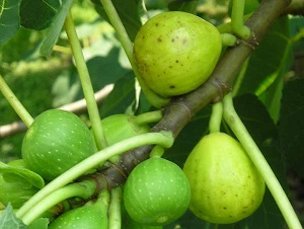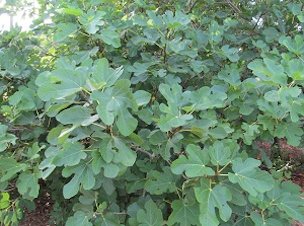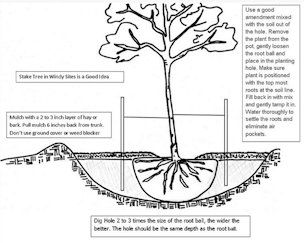Fact Sheet from
the Just Fruits and Exotics Nursery
by Brandy Cowley Gilbert
Choosing the
Right Fig Variety

Fig. 1
Figs (Ficus carica)
are one of the easiest, most problem-free fruits you can grow. Not many
people realize the range of varieties and the differences in textures
and flavors among varieties. Some have a light, sweet, maple- syrup
flavor while others are as thick and rich as strawberry jam. Most
people are familiar with the summer ripening varieties but are unaware
of the range of fall ripening figs. With proper variety selection it is
possible to have tree-ripe figs from July through September. If birds
are a problem choose a light skinned variety. Birds have a built-in
notion that ripe figs are dark. They tend to leave the green skinned
varieties alone.
We have selected and propagated over 20
self-fertile varieties suitable for home growing in the humid
Southeast. Varieties requiring a fig wasp pollinator cannot be grown
outside of commercial fig-growing areas in California because the fig
wasp is absent. All figs suitable for the Southeast United States are
self- pollinating. In addition, we suggest the group called closed eye
figs. At the bottom of the fruit is an opening known as the eye. Water
or insects can pass through this opening and cause fruit rot. Varieties
with a long neck or peduncle allow the fruit to droop, preventing
moisture or pests from entering the eye.
People in the far north
that are subject to cold weather (zones 7) and they often are most
successful with fig varieties that produce a breba crop. The breba crop
is born on the last flush of growth of last year branches. These are
the first figs of the year to ripen and in short summer season areas
the ones that ripen before the first freeze.
Breba crop
varieties are also good for southern climate gardeners as they will
have a longer ripening season. The breba crop is early ripening in June
and the main crop comes on in August and beyond.
Landscaping
with Fig Trees…..

Fig. 2
Small by nature, the fig tree is ideal for use in the shrubbery
border. Their distinctive leaves make an excellent accent or specimen
tree. Try mingling the broad, deeply lobed leaves of the fig with the
willowy pomegranate and fine- textured, misty blue tones of the
blueberry. Tie it all together with a lush groundcover of strawberries
for a never-ending cycle of flowers, fruit and fall color.
The
smooth, limber trunk of the young fig is perfect for training into
espalier or twisting into odd specimen trees. Lay the trunk flat
against the ground and the new vertical shoots make an instant hedge.
Small-space gardeners take note. The root restraint of container
growing brings extra-bountiful crops from the fig.
Site
selection and correct spacing for fig trees
Figs
will grow on a wide range of soils when good drainage is provided. Figs
grown in soils high in organic matter or clay content are less subject
to nematode damage. Plant in full sun for vigorous growth and good
fruit crops. Avoid frost pockets – and damage by unseasonable
frosts. Spacing for figs depends upon the desired use in the
landscape. Bushes can be planted individually or in a hedgerow.
Individual tree spacing is 15 to 20 feet. If planting a hedgerow, space
6-10 feet apart. All figs suitable for the Southeast are
self-pollinating, so bushes may be planted as desired in the landscape.

Fig. 3 
Figs
prefer slightly acid soil (pH 5.5-6.5), but soils of up to moderate
alkalinity are readily tolerated. If you are in doubt about the acidity
of your soil, it is very easy to take a sample to the Cooperative
Extension agent in your county for a soil test. Adjust soil pH as
necessary. Dig a planting hole approximately three times the width of
the pot and at the same depth as the root ball. Set that soil aside and
mix it 50/50 with either aged mushroom compost, aged manure, or rotted
pine bark & aged manure/compost. Remove the plant from the pot,
gently loosen the root ball and place in the planting hole. To avoid
burying too deep, make sure plant is positioned with the top most roots
at the soil line. Fill the planting hole with the mix of soil and
organic matter; gently tamp it in. Water thoroughly to settle the roots
and eliminate air pockets. Do NOT put fertilizer in the planting hole.
Only apply fertilizer if it is the correct time of year (see
Fertilization section below).
Mulching fig
trees
If
desired, construct a water basin around the base of the fig
approximately 36 inches in diameter. Mulch in spring and summer with
approximately 6-8 inches of mulch. Pull mulch a couple of inches away
from the trunk for good air circulation. Mushroom compost and rotted
manure are excellent mulches for fighting off nematodes in figs. Keep
the area under the tree canopy clear of grass and weeds to minimize
competition for water and nutrients.
Fertilizing
fig trees
The
type of fertilizer you choose may be chemical or organic. Make sure
that the fertilizer contains iron, zinc, manganese, magnesium,
molybdenum, copper and boron. These minor elements are very important
to plants and most soils are low in these elements. Application rates
vary according to age of plant. See chart below.
| 10-10-10
or 10-0-10 with minerals |
1
cup per each year of trees life
-Max out at 9 cups on mature Trees |
Espoma
Citrus Tone
(Organic) |
6
cups for 1 year old
10 cups for 2 year old (4-6ft)
18 cups for 7-9ft tree
24 cups for tree over 9ft |
Spread
the fertilizer evenly under the entire canopy of the plant avoiding a
5-inch area around the trunk. Water or rake in. For Zones 9-10,
fertilize 3 times each year in late February, late May and
late
July/early August. For plants further north (Zones 7-8b), fertilize in
March or after bud break. Never fertilize after August (June in Zones
7-8b) as this will promote new growth late in the year which will be
subject to freeze damage.
Watering fig
trees
The
first year is the critical time for the establishment of a new fig.
Water thoroughly twice a week on light soils and once a week on clay
soils. Soak the entire root system deeply – this usually takes
40-50 minutes. Figs should receive at least 1 inch of water each week
for best growth and fruit production. Water regularly, especially
during dry periods. Fruit may drop prematurely if insufficiently
irrigated during dry spells.
Insects and
diseases
Root
knot nematodes may be a problem on sandy soils. Trees weakened by
nematodes do not grow well and may not fruit. You probably have
nematodes if you find small knots on the roots. In our area, nematodes
may be reduced or eliminated through the use of heavy mulches and
incorporation of large amounts of organic matter in the soil at the
time of planting.

Fig. 4 
Fig rust
Fig rust can be a problem in rainy seasons. It shows up as rusty brown
discoloration on the leaf, resulting in distorted leaves and early leaf
fall. This fungus can be controlled with a copper spray applied every
2-3 weeks from June to August. In addition, rake and burn fallen leaves
in the fall or apply a heavy layer of mulch in the spring, to remove
the source of fungal spores that might re-infect the tree the following
year.
Always remember that good disease resistance begins with
the health of the plant. Plants stressed from lack of water, not enough
sun or being underfed are more susceptible to disease and insects.
Maintaining
good sanitation practices in the orchard is most important. The removal
of diseased and dead wood, and picking up fallen or rotting fruit off
the trees as it occurs, will go a long way in keeping disease and
insects at a minimum. Spray at first sign of an issue, rather than
waiting until the problem is out of hand will go a long way to keeping
your plants healthy and fruiting properly.
Frost
protection
Very
young figs may be damaged or killed at temperatures below 25°F. For the first year after planting we suggest that trees be
covered. This is especially important in trees that have not entered
dormancy or which have begun growth in the spring. If an established
tree sustains frost damage, wait until growth has resumed in the spring
to assess injury and remove dead limbs. With age the tree will develop
a certain degree of cold tolerance.
Older trees are less subject
to colder weather, but can be damaged by sudden dips or temperatures
below 20°F. Some things to keep in mind when preparing your trees, is to
stop fertilizing in after May in northern zones (7-8A) and after July
in southern zones (8b-9). Slow you watering down in the fall to allow
the tree to harden off. If you know you are going into a very cold
spell and the tree still has leaves or green tips cover it for the
night.
For Zone 7 and above, figs must be protected from winter
cold. We suggest that the plants be surrounded by a wire cage and
mulched heavily with leaves. The cage should be topped with tarpaper or
plastic to keep the branches dry in the winter. Remove the cage and
mulch in the spring after it warms.
Figs grown as container plants
are also subject to frost damage since roots are above ground in a pot.
Container figs should be kept at or above 25°F during winter. The
grower of container figs will be rewarded with a good crop, since root
restriction in figs promotes heavy fruit.
Learn how to
hasten your fig ripening in short season areas
People
that live in areas with short seasons are often in a race to get their
figs to ripen before cold weather sets in. To get the best success do a
couple of things. First choose a variety that will ripen a good breba
crop. Breba crops fig varieties that fruit on the growth of last years
wood. This crop will ripen in early summer. The second crop is the main
crop and it is born on the new growth that arises in the spring. Often
this crop can be induced to ripen sooner by oiling the fruit. Oiling
blocks the eye of the fig, inducing ethylene to form, that is what
hastens the ripening. You’ve got to get the fig close to ripening
before the oil will work. Usually the best ones to do, are ones that
are good size and you can see some coloring around the eye. You can use
olive oil or any other refined edible oil. Just use a dropper to place
the oil in the eye of the fig.
Back to
Fig Page
|
|
Bibliography
Cowley
Gilbert, Brandy. "Choosing the Right Fig Variety." Just Fruits and Exotics, justfruitsandexotics.com. Accessed 12 Mar. 2017.
Photographs
Fig. 1,2,3,4 Cowley Gilbert, Brandy. "Choosing the Right Fig Variety." Just Fruits and Exotics, justfruitsandexotics.com. Accessed 12 Mar. 2017.
Published 12 Mar. 2017 LR
|


